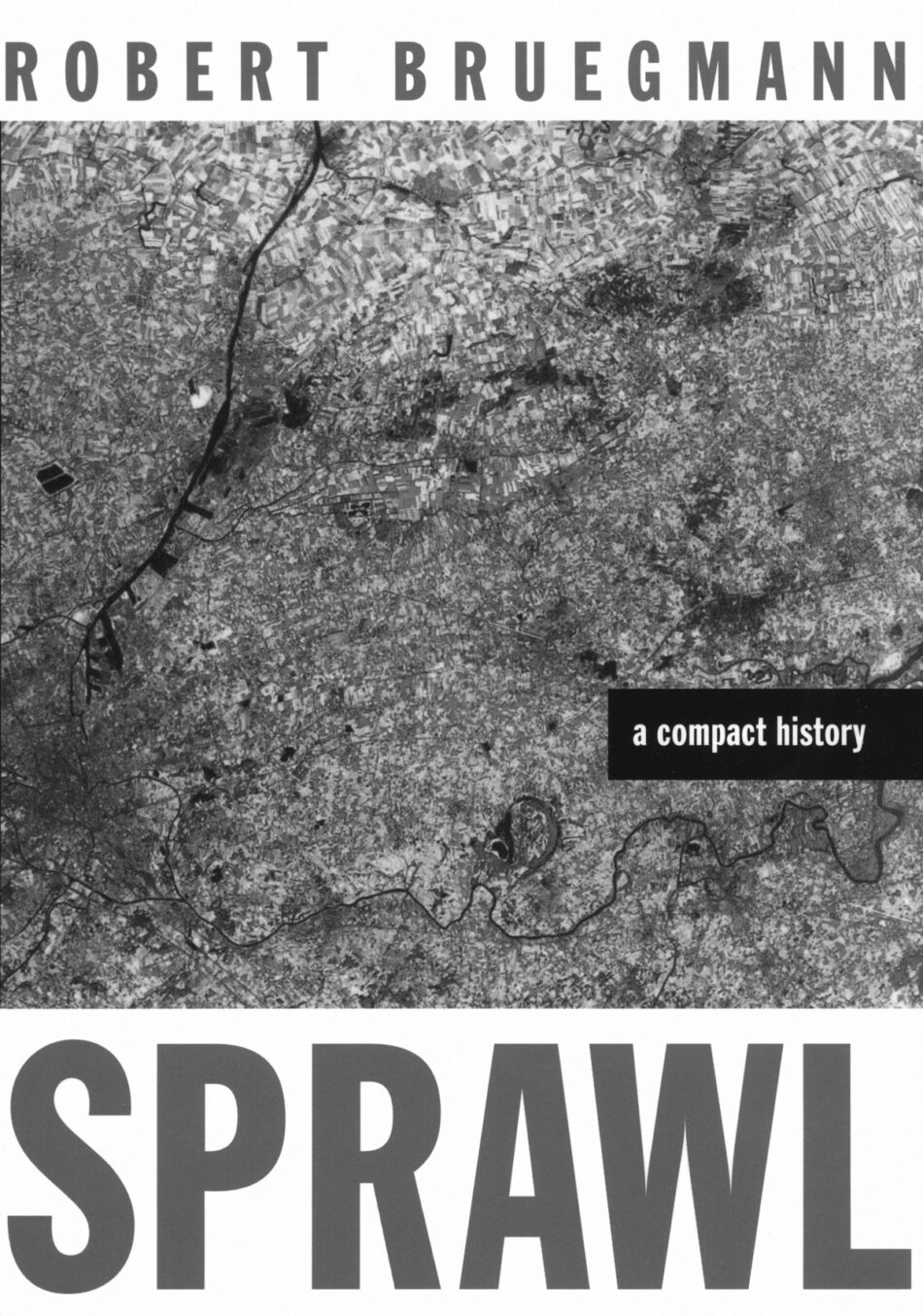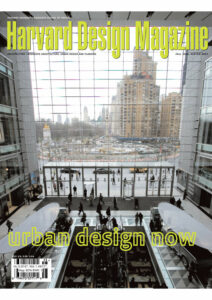Sprawl: A Compact History by Robert Bruegmann
Robert Bruegmann’s Sprawl: A Compact History is a very good and timely book, and I recommend it to anyone interested in cities or general patterns of human settlement. The book is meticulously researched, ambitious in historic scope, well reasoned, and enjoyable to read. It offers a carefully balanced, non-polemical overview of a subject much polemicized in recent times. I even enjoy the wit contained in the title. Unfortunately, and for some of the same reasons, I predict that few will extol the book’s virtues, because few today feel neutral about sprawl, or seek a balanced argument on behalf of sprawled America. Sprawl’s legion of condemners will express outrage, and find Bruegmann irresponsible. How can anyone, they will ask, in this day an age, especially an eminent historian of urbanization, defend the destructive impacts of sprawl? Whereas the defenders of sprawl, in the minority today but quite outspoken on the subject of protecting property rights, even in landowners’ decision to sprawl, will regret that the book is not more of a manifesto in favor of sprawl, though some may claim it as such.
Bruegmann stops short of championing sprawl in all of its manifestations, though he enumerates various appeals of low-density urbanization. Still, while he touts many social and economic benefits that he sees resulting from the modern era of decentralized metropolitan growth, he acknowledges that decentralization also yields less positive consequences on society. His principal shots across the bow of the anti-sprawl movement are three-fold: First, he rejects today’s pervasive idea that sprawl has and continues to be forced upon Americans by some complicit combination of careless public policy, corporate marketing (namely related to the auto and affiliated industries) and greedy land developers and home builders. He argues that the majority of Americans, and others across the world to whom similar choices are available, actually like the less dense environments that they inhabit. People surely prefer the sprawl of their own making, though Bruegmann admits that those enjoying their sprawl increasingly object to the additional sprawl being produced by newcomer neighbors.
Secondly, and as a partial rebuttal to the idea that sprawl is forced upon us, Bruegmann points to preferences for sprawl across cultures and across history. Here Bruegmann’s command of urban history yields numerous statistics and examples of horizontal urban spread from ancient Rome to the capitals of contemporary Europe, the latter often used by sprawl-busters as the antithesis of homogenous, sprawling American metro areas. He makes a compelling case that in many cultures it is growing affluence, with its resulting expansion of available dwelling choices, which historically leads to peripheral urban expansion. It is hard to deny that the traditional members of the three “P’s,” the powerful, the privileged, and the pious (as in popes and cardinals), consistently succumbed to the temptation of building villas and estates out in the countryside, so as to enjoy escape from the rasping frictions of urban centers. So why is it so odd to assume, he asks, that similar choices would not be taken in the modern era, once resources and technologies made it possible, by members first of the merchant and business classes, and finally you and me. Some anthropologists even theorize that humanity is biologically wired to thrive, or be attracted to, smaller social groupings and natural settings, rather than enormous congregations of population. So Bruegmann intimates, as others have done, that the highly compact, dense, 19th-century industrial city—the city that aroused Charles Dickenson’s ire, not admiration—may have been an aberrant form of human settlement, rather than a model for contemporary urbanization as some sentimentally assert.
Thirdly, Bruegmann sets out to challenge some of today’s near-hysterical claims about the destructive impacts of sprawl. He would like to detoxify the term, and in part does so by accounting for its various definitional associations, meanings that shift across time and across people’s different perspectives on suburbanization. He reminds us that for much of American history, really from Jefferson’s time on, decentralization was considered progressive, a social good, and a measure of citizens’ economic advancement, the opposite of a major social problem. And he points out that such associations still exist, and continue to support the sprawling instinct.
The book is organized into three parts. The first six chapters establish his position by outlining the difficulties of defining sprawl exactly, by reviewing its many causes while challenging some of the accusations made by opponents, and by offering examples across urban history of its persistence. Thus, he methodically removes sprawl from the common supposition that it is unique to our time. The next four chapters are dedicated to different (and for him somewhat doomed) anti-sprawl campaigns. These include the arguments against urban spread made in Britain during the 1920s, understandable as London was already one of the world’s largest and most spread out cities; reactions in America, largely from academics, planners and others whom he terms “elites”, against the rapid suburbanization in the post-World War II period; and finally the current campaign, accelerating in intensity since the late 1970s and maturing today under slogans such as new urbanism and smart growth, the campaign that surely motivated him to write this book. But all these he sees as merely recurring arguments from an even earlier time, as he states in the short chapter introducing the three campaigns: “virtually every argument leveled against sprawl today can be found in [the] description of London and other European industrial cities in the 19th-century.” Later on he refers further back in history still, for example, to Queen Elizabeth’s effort in the 16th-century to prohibit building at the edges of London, a prohibition that, of course, had little long-term effect.

The final three chapters are devoted to discussing, and generally pointing out the very limited success, of what he terms remedies to curb sprawl. On these pages he rightly notes the inevitability, and cites many examples, of gainers and losers that result from any substantial efforts to control land use and urbanization. He acknowledges that centralized government authority can control urban expansion, for example citing the success of Soviet Moscow’s efforts to control peripheral growth, but questions whether such success outweighs the disadvantages caused by limiting citizens’ choices. He offers a lengthy and thoughtful assessment of America’s most famous metropolitan effort at controlling sprawl, the case of Portland, Oregon. While acknowledging the courage of the effort, he generally sides with more recent skeptics who wonder whether it has been the growth boundary measures or the generally slow regional population growth of Portland, say by comparison to Houston or Phoenix over the same time period, that has helped retain many of the urbane characteristics that advocates of Portland’s livability cite. He notes that the overall density of the Portland metro area is significantly lower than that of Los Angeles, the longstanding poster child of uncontrolled sprawl. He worries, as others recently have, about various inequities that may have been inadvertent consequences of land use policies, such as rapid increase in land values, or unforeseen diminishment in transit usage by the switch to higher profile light rail systems at the expense of the number of bus lines, thus actually reducing the overall percentage of the population with convenient access to transit. I am sure that he is not surprised at the victory of last year’s referendum (following the publication of Sprawl) that seeks monetary compensation for landowners outside the growth boundary claiming loss of value to their land resulting from the growth boundary. This is generally seen as a serious backlash to Portland’s generations-long experiment in regional land-use controls.
While I generally admire Bruegmann’s nuanced review of the causes and appeals of sprawl, and his determination to rebalance the social and economic arguments for and against sprawl, and while I concur with his supposition that there is a certain inevitability to horizontal spread of urban populations, I do fault him for remaining all to silent on sprawl’s consumptive nature. Low-density settlement may be appealing to many who enjoy the lifestyle or profit from it, whether real estate moguls or individual homeowners, but it is hardly an efficient use of land or the world’s resources. And the cumulative burdens upon the environment of pervasive urban sprawl cannot be wished away by the popular appeal of sprawl. There is that not insignificant problem of multiplication that Bruegmann ignores. If three hundred million Americans choose to sprawl, much less a billion affluence-and-freedom-gaining Chinese (!), that is quite a different matter than several thousand Englishmen planting themselves on the outskirts of 16th-century London.
Worldwide environmental degradation has many causes, but sprawl is certainly a contributor. A billion “sprawlers” IS a cause for worry. Few can argue that low-density development does not increase auto emissions, water use, pollution, trash, loss of species habitat, and energy consumption. To cite one example, most pollution of groundwater, lakes, streams, and rivers in the United States is caused by runoff that collects various toxins on the high percentage of impervious surfaces, like roads and parking lots, in urbanized regions. The heating and cooling of freestanding homes, with their many exterior walls per capita, requires more energy than attached, denser development. And then there are those immaculate lawns that require ample water and chemicals to maintain. Of course, most such conditions are caused by increasing affluence, not just settlement patterns, though affluence and sprawl are quite related as Bruegmann consistently points out. Bruegmann remains just a little too sanguine about the environmental consequences of sprawl. There is little doubt that calls for better environmental stewardship-leading to legislated restrictions on development-will increase in the coming decades, influencing urbanization patterns considerably at least in the developed world.
Bruegmann’s courageous narrative would have even more force had he concluded, even as he articulated the historic benefits of sprawl, that what some call or hope will become “The Green Millennium” needs to unfold freer of sprawl than the prior one.
Robert Bruegmann, Sprawl: A Compact History (Chicago: University of Chicago Press, 2005).
